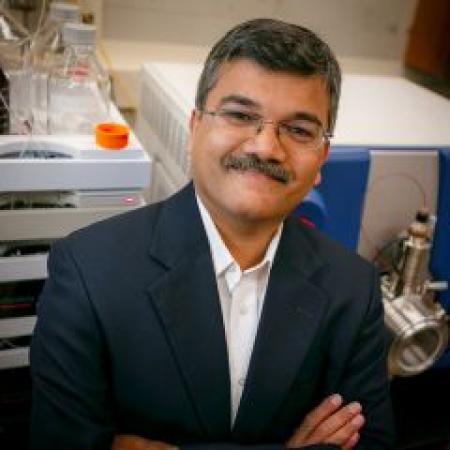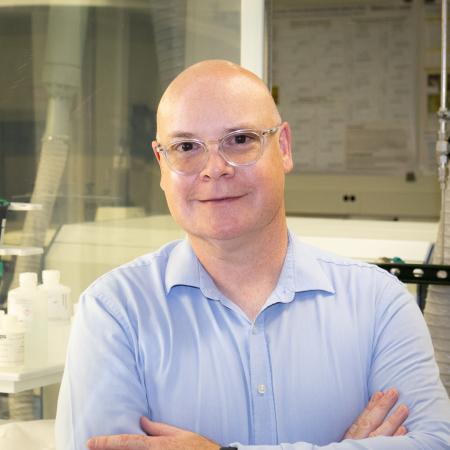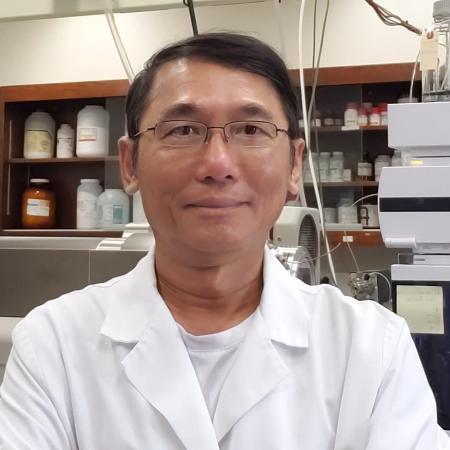The Division of Environmental Health Sciences (DEHS) includes the laboratories of Organic Analytical Chemistry, Inorganic and Nuclear Chemistry, and Environmental Biology. From the air we breathe, to the water we drink, the food that we eat, and even the types of consumer products we use, environmental contaminants can get into our bodies and affect our health. DEHS scientists are focused on identifying and mitigating those exposures through:
- Exposome – understanding the human exposome, which is the measure of all the exposures of an individual in a lifetime beginning with the prenatal life stage and continuing throughout other life stages with exposures from the environment, diet, lifestyle, etc., interacting with our own unique genetics and physiology.
- Human biomonitoring – use of mass spectrometry to analyze blood, urine, saliva, and other human tissues for exposure to toxic metals (e.g., lead and mercury), organic chemicals (PFAS, pesticides, phthalates) and emerging endocrine disrupting chemicals.
- Environmental monitoring – as NY State’s Principal Laboratory under EPA’s Safe Drinking Water Act, we analyze drinking water, non-potable water, and other sample matrices for microbiological, chemical, and radiological contaminants.
- Emergency response – laboratory preparedness to respond to chemical threats, nuclear incidents, and microbial outbreaks, through environmental and clinical analyses.
- Graduate education – DEHS maintains a strong partnership with the Department of Environmental Health Sciences at the University at Albany, School of Public health, serving as faculty and educating the next generation of environmental health scientists.
State-of-the-Art Analytical Instrumentation
The Environmental Health Sciences’ Organic Analytical, Inorganic and Nuclear Chemistry Laboratories are equipped with state-of the art analytical instrumentation, only a portion of which are listed below:
- High resolution magnetic sector, time of flight and Orbitrap mass spectrometers
- Gas chromatographs and liquid chromatographs connected with different kinds of detectors
- Inductively coupled plasma-mass spectrometers (ICP-MS) including sector field high resolutions mass spectrometers
- ICP-optical spectrometers
- X-ray spectrometers
- Atomic absorption spectrometers
- Alpha and gamma counters
- Liquid scintillation counters
- Transmission electron microscopy
Environmental health research areas include: Atmospheric Chemistry, Environmental Analytical Chemistry, Environmental Biology, Exposome and Biomonitoring, Food Chemistry, Medical Geology and Nuclear Chemistry. Links to these areas are found in the menu.
See Select Featured Laboratories in Environmental Health
Associated Researchers

Liang T. Chu, PhD
Environmental Heterogeneous Chemistry Laboratory
We investigate heterogeneous reactions occurring on ice, environmental particle and nanoparticle surfaces to better understand the atmospheric pollution processes and their impact on human health using spectroscopic techniques.

George L. Donati, PhD
Deputy Director - Laboratory of Inorganic and Nuclear Chemistry
We develop new approaches to calibration and use advanced statistical tools to minimize matrix effects and improve the accuracy and sample throughput of spectrochemical methods such as MIP-OES, ICP-OES, and ICP-MS to determine trace elements in a wide variety of samples of public health interest.

Bryan C. Duffy, PhD
Supervisor, Emerging Contaminants in Drinking Water Program / Liquid Chromatography
We focus on the targeted, ultra-trace measurement of emerging organic contaminants in New York State’s drinking water supplies through both regulated and research-based mass spectrometry methods.

Sherry A. Faye, PhD
Director, Nuclear Chemistry Laboratory
We focus on method development of radiochemical analyses for use in routine and emergency response scenarios.

Theresa K. Hattenrath, PhD
Chief, Laboratory of Environmental Biology
We use a variety of techniques to develop and validate rapid methods for the detection of waterborne pathogens, or their indicators, prior to the outbreak of disease.

Kurunthachalam Kannan, PhD
Deputy Director of the Division of Environmental Health Sciences
Biomonitoring of human exposure to environmental chemicals; biomarkers of health effects; sources and pathways of human exposure; environmental distribution, food chain transfer and fate of organic pollutants; consumer product analysis; overdose and wastewater surveillance

Haider A. Khwaja, PhD
Environmental Atmospheric Chemistry Laboratory
We conduct multidisciplinary research to understand water and indoor and outdoor air pollution and their impact on human health.

Christopher D. Palmer, PhD
Deputy Director, Clinical Trace Elements Laboratory
We develop and maintain robust ICP-MS methodologies to support both human biomonitoring studies and emergency preparedness.

Patrick J. Parsons, PhD
Director, Division of Environmental Health Sciences
We study human exposure to toxic metals/metalloids (biomonitoring) and long-lived nuclides (radiobioassay); and develop novel speciation methods by coupling LC and GC to ICP-MS, while using portable XRF for field-based studies.

Buu N. Tran, PhD
Organic and Analytical Chemistry Laboratory
We develop analytical methods to identify unknown chemicals in foods and environmental samples including toxic compounds and chemical terrorism agents, thus providing national surveillance of the food supply.